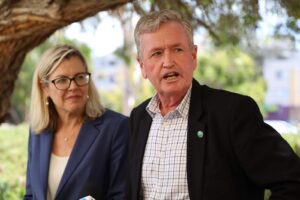On Sunday the 18th of February this year at 5 minutes to 6pm the south west power grid hit a new record in demand of 4,233 Megawatts (MW).
It happened on the hottest day in Perth that month, with the temperature hitting 42.9 degrees Celsius. In fact in February we had seven days with maximum temperatures over 40 degrees and another seven with maxima between 35 and 40.
That’s half of the month we were sweltering in!
No doubt the air conditioners connected to the South West Interconnected System (the SWIS) were working hard.
WA managed to keep the power on to keep the air conditioners running and the lights on, but how it did so is illuminating.
In the first instance it was relying on gas and goal running at near full capacity.
At 5:55pm the state’s gas fired power stations were contributing 2,528 MW of power, or 58% of the power being generated.
Our coal fired power stations at Collie were going flat out producing 1,364 MW or 32% of the generation.
Which means our fossil fuel generation was producing 90% of the power the state needed to keep the lights on when the heat was on.
Of the other power sources contributing at 5:55pm that day, rooftop solar was producing 90 MW (2%); solar farms were producing 13MW (0.3%) and wind farms were producing 203 MW (4.8%).
The big battery in Kwinana was able to add 86 MW or 2% at the same time.
So, when we needed it most, gas and coal was delivering 90% of our electricity and the rest of the sources the other 10%.
And to reinforce the point, if all our coal generators are operating at their recognised maximum capacity our coal fired generators can reach 1,373MW. They were running flat out! Our gas generators weren’t far behind.
And we need to remember that at the same time the market operator was paying businesses in this state to slow down or stop production, so the demand was actually higher, and without shutting down business the system may have failed.
Which is why I am greatly concerned at the State Government’s agenda to shut down our coal generators without building more gas generation to replace it and without building anything like enough renewable energy capacity and the concurrent transmission and storage.
The Government is planning to close down all state coal generators over the next five years, losing 940 MW of capacity.
They also seem determined to drive the private coal generator Bluewaters out of business, supplies 434MW.
The total loss of 1,373MW will not only need to be replaced, but the Government will need to supply even more power because predictions are that power demand is going up, not down.
The peak demand of 4,300 MW today is expected to grow to over 6,000 MW by the energy operator, the Australian Energy Market Operator (AEMO).
Demand is going up as supply is being cut. Which would be ok if the State Government had a reasonable and funded plan to replace and increase our generation capacity.
Unfortunately, it does not.
The current plan is inadequate and largely unfunded.
It calls for 400 MW of additional wind farm construction for general sales, and another 400 MW to power the new desalination plant. (The current plant is also supposed to run entirely on renewables but it doesn’t, and it gets shut down to save power when the system runs short.)
The amount of renewable generation and battery storage required to replace the reliable coal plants is not in the Government’s plan or in its budget.
Of course, there are private companies looking to invest in renewable generation as the Government fails to adequately do so.
But you should have no doubt that the lack of Government action will see your power bills skyrocket in coming years to pay for a service that will become less and less reliable.
There is no way the Government will deliver enough power under the current plan.
It will take years to build and engage enough renewable generation, transmission and storage to replace the current coal fleet. The approvals alone take years.
They will need to add some additional gas generation capacity to cover the shortfall until renewables can fill the void.
And they will need to look at all technologies and processes to make it work.
The current plan will see the lights go out, air conditioners stop, and businesses will still have to be shut down to reduce demand. It will also drive up your power prices.
That is failure to plan, or perhaps a plan to fail.


